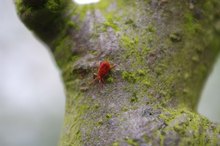What does fact checked mean?
At Healthfully, we strive to deliver objective content that is accurate and up-to-date. Our team periodically reviews articles in order to ensure content quality. The sources cited below consist of evidence from peer-reviewed journals, prominent medical organizations, academic associations, and government data.
- BioMed Research International: The Efficacy of Allergen Immunotherapy with Cat Dander in Reducing Symptoms in Clinical Practice
- BioMed Research International: The Efficacy of Allergen Immunotherapy with Cat Dander in Reducing Symptoms in Clinical Practice
- Current Opinion in Allergy and Clinical Immunology: The Role of Indoor Allergens in the Development of Asthma
- Current Opinion in Allergy and Clinical Immunology: The Role of Indoor Allergens in the Development of Asthma
- The World Allergy Organization Journal: Anaphylaxis as a Manifestation of Horse Allergy
- The World Allergy Organization Journal: Anaphylaxis as a Manifestation of Horse Allergy
The information contained on this site is for informational purposes only, and should not be used as a substitute for the advice of a professional health care provider. Please check with the appropriate physician regarding health questions and concerns. Although we strive to deliver accurate and up-to-date information, no guarantee to that effect is made.
Allergic Reactions From Pet Dander
Not everyone is allergic to pet dander, but among those who are, symptoms range from mild to severe. Avoiding animals is often the most effective way to prevent an allergic reaction. When animals are unavoidable, however, treatments are available. Pet dander allergy symptoms are similar to those of other airborne allergies, such as hay fever.
If you are experiencing serious medical symptoms, seek emergency treatment immediately.
Symptoms
Mild pet dander reactions include sneezing; itchy, watery or red eyes; tickling in the back of the throat or roof of the mouth; or an itchy nose. It is not unusual for symptoms to begin as mild, then become more severe, the longer a person is exposed to pet dander.
In addition to these respiratory symptoms, an allergic reaction of the skin, called allergic dermatitis, can occur. Sometimes the rash will be made of hives, or raised, red patches of skin. The skin will likely itch.
- Mild pet dander reactions include sneezing; itchy, watery or red eyes; tickling in the back of the throat or roof of the mouth; or an itchy nose.
- In addition to these respiratory symptoms, an allergic reaction of the skin, called allergic dermatitis, can occur.
Function
Allergy to Live Chickens
Learn More
Pet dander isn't really a harmful agent to the human body. An allergic reaction, however, represents the body's immune system reacting to the dander as if it is a harmful, potentially infectious agent. The immune system sends messages to different parts of the body, which produce histamine to fight off the dander. Histamine causes all of the symptoms of an allergic reaction.
- Pet dander isn't really a harmful agent to the human body.
- An allergic reaction, however, represents the body's immune system reacting to the dander as if it is a harmful, potentially infectious agent.
Sources
Dander is found in animal skin cells, saliva or urine. Both cats and dogs can shed hair and skin cells wherever they go. Allergic reactions can be caused by these animals, and less commonly by other animals such as horses. The American Lung Association points out that about twice as many people report allergies to cats than dogs 3. Licking is a common practice in animals when they are cleaning themselves. The saliva from the tongue can leave dander on the fur that is shed. Many pets lick as a sign of affection, which can also provoke an allergic response, especially allergic dermatitis.
- Dander is found in animal skin cells, saliva or urine.
- The saliva from the tongue can leave dander on the fur that is shed.
Treatment
The Signs and Symptoms of Flea Bite Allergies in Humans
Learn More
Vacuuming often can reduce pet dander, but it isn't likely to completely rid the home of the allergen. It can take several weeks for the allergens to die down in the home. Most allergic individuals must choose to live without pets or take an antihistamine daily. Antihistamines work by blocking the production of histamine triggered by dander. Without histamine, the body does not produce the annoying symptoms associated with the allergic reaction. Individuals with only a topical allergy can wash the saliva off immediately and apply an antihistamine cream. Other common treatments include corticosteroids to fight inflammation, decongestants to relieve sinus congestion, and nasal irrigation with saline solution.
- Vacuuming often can reduce pet dander, but it isn't likely to completely rid the home of the allergen.
- Other common treatments include corticosteroids to fight inflammation, decongestants to relieve sinus congestion, and nasal irrigation with saline solution.
Complications
Individuals with both asthma and pet dander allergies are at an increased risk of asthma attack when exposed to pet dander. Dander exposure can cause:
- difficulty breathing
- chest tightness
- pain in the chest
- wheezing or other noises with exhalation,
- waking due to shortness of breath or coughing
Related Articles
References
- BioMed Research International: The Efficacy of Allergen Immunotherapy with Cat Dander in Reducing Symptoms in Clinical Practice
- Current Opinion in Allergy and Clinical Immunology: The Role of Indoor Allergens in the Development of Asthma
- American Lung Association: Pet Dander
- The World Allergy Organization Journal: Anaphylaxis as a Manifestation of Horse Allergy
- Quirt J, Hildebrand KJ, Mazza J, Noya F, Kim H. Asthma. Allergy Asthma Clin Immunol. 2018;14(Suppl 2):50. Published 2018 Sep 12. doi:10.1186/s13223-018-0279-0
- Chan SK, Leung DYM. Dog and Cat Allergies: Current State of Diagnostic Approaches and Challenges. Allergy Asthma Immunol Res. 2018;10(2):97–105. doi:10.4168/aair.2018.10.2.97
- Gergen PJ, Mitchell HE, Calatroni A, et al. Sensitization and exposure to pets: The effect on asthma morbidity in the US population. J Allergy Clin Immunol Pract. 2018;6(1):101-107.e2.doi:10.1016/j.jaip.2017.05.019
- Milanzi EB, Koppelman GH, Smit HA, et al. Role of timing of exposure to pets and dampness or mould on asthma and sensitization in adolescence. Clin Exp Allergy. 2019;49(10):1352-1361.doi:10.1111/cea.13471
- Mendy A, Wilkerson J, Salo PM, Cohn RD, Zeldin DC, Thorne PS. Exposure and sensitization to pets modify endotoxin association with asthma and wheeze. J Allergy Clin Immunol Pract. 2018;6(6):2006-2013.e4.doi:10.1016/j.jaip.2018.04.009
- Hon KL, Tsang KYC, Pong NHH, Leung TF. Relevance of Cat and Dog Sensitization by Skin Prick Testing in Childhood Eczema and Asthma. Curr Pediatr Rev. 2017;13(2):120-125.doi:10.2174/1573396313666170615085018
- Ling M, Long AA. Pet dander and difficult-to-control asthma: Therapeutic options. Allergy Asthma Proc. 2010;31(5):385-91.
- Williams AA, Cohn JR, Fung SM, Padams P. The efficacy of allergen immunotherapy with cat dander in reducing symptoms in clinical practice. Biomed Res Int. 2013;2013:324207. doi:10.1155/2013/324207
- Sublett JL. Effectiveness of air filters and air cleaners in allergic respiratory diseases: a review of the recent literature. Curr Allergy Asthma Rep. 2011;11(5):395–402. doi:10.1007/s11882-011-0208-5
- Dilley MA, Phipatanakul W. Environmental control measures for the management of atopy. Ann Allergy Asthma Immunol. 2017;118(2):154–160. doi:10.1016/j.anai.2015.12.029
- Nicholas CE, Wegienka GR, Havstad SL, Zoratti EM, Ownby DR, Johnson CC. Dog allergen levels in homes with hypoallergenic compared with nonhypoallergenic dogs. Am J Rhinol Allergy. 2011;25(4):252–256. doi:10.2500/ajra.2011.25.3606
- Kelly LA, Erwin EA, Platts-Mills TA. The indoor air and asthma: the role of cat allergens. Curr Opin Pulm Med. 2012;18(1):29–34. doi:10.1097/MCP.0b013e32834db10d
Writer Bio
Sarah Harding has written stacks of research articles dating back to 2000. She has consulted in various settings and taught courses focused on psychology. Her work has been published by ParentDish, Atkins and other clients. Harding holds a Master of Science in psychology from Capella University and is completing several certificates through the Childbirth and Postpartum Professional Association.








